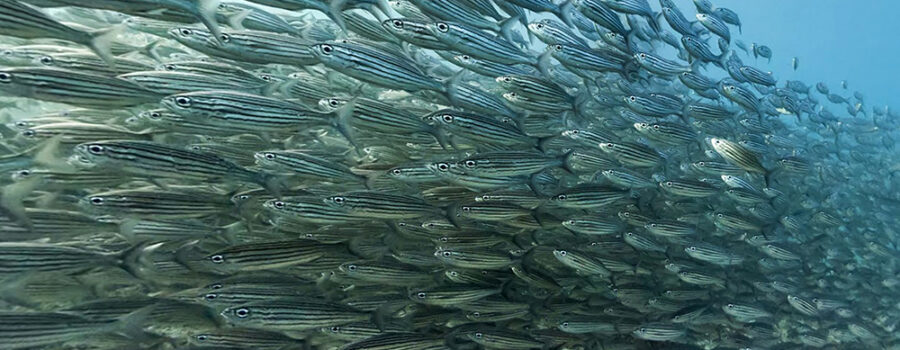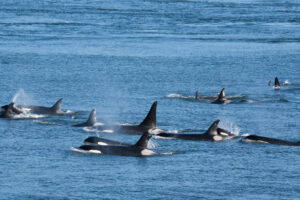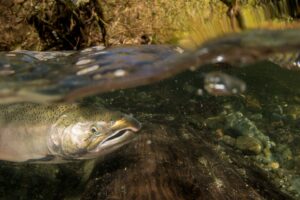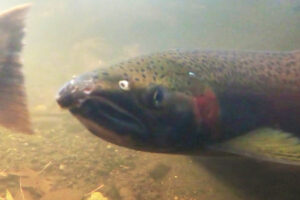Chickens are terrestrial birds. They naturally scratch and peck the ground for seasonal plants, seeds, insects, and grubs to eat. They do not naturally eat fish from the ocean. Industrial fishing and industrial agriculture have changed that. We now catch millions of tons of small fish in the ocean, turn them into fishmeal and fish oil, and feed them to farmed fish, pigs and chickens. In doing so, we are critically threatening the stability of marine food webs around the world.
Demand for fishmeal
In 2018, the global fish catch amounted to 96 million tons of fish. 18 million tons of that were pressed to extract fish oil, then dried and ground into fishmeal.1 When you have by-products from fish processing (heads, bones, tails, etc.) that would otherwise be wasted, grinding it into fishmeal to be used elsewhere is smart. 25–35% of fishmeal and fish oil comes from these by-products.2 The rest of the total volume – roughly 13 million tons – comes from fish that are caught for this purpose. This is not smart.
The species hunted for fishmeal are generally small forage fish such as anchovies, sardines, herring, sand lance, and smelt. In the ocean, these forage fish are prey for larger species in the marine food web – larger fish, birds, and mammals. They are also a primary protein source for millions of people in developing economies.
Demand for fishmeal has fueled industrial fishing practices that are now seriously depleting fisheries of prey fish. Seven of the world’s top ten fisheries (by volume) target forage fish.3 Despite improved fishery management in some parts of the world, the overall proportion of fish stocks that are within biologically sustainable levels has decreased from 90% in 1974 to 65.8% in 2017.4
How fishmeal is used
One use for fishmeal and fish oil is as low cost, high-calorie animal feed for farmed fish, pigs, and chickens. Data from 2009 shows that 46% of fishmeal and fish oil was fed to farmed fish, 24% to pigs, 22% to chickens, and 8% went into pet food and pharmaceuticals.5

Clearly, the largest consumers of fishmeal and fish oil are farmed fish, but the issues surrounding marine fish farming are significant enough to warrant coverage in a separate article.
Connection to the Salish Sea
This is clearly a global problem, so what’s the connection to the Salish Sea? The small prey fish on the Pacific Northwest coast and in the Salish Sea are under assault too.
Canada’s Department of Fisheries and Oceans (DFO) opened the last viable Pacific Herring fishery on the British Columbian coast for the 2020 season in the face of strong local opposition. 4 out of 5 Canadian herring fisheries have already closed due to overfishing.6 This last fishery in the Strait of Georgia has seen a 60% decline over the last 4 years. By the end of the 2020 season, 9,090 tons of herring were captured.7 88% of the catch became fishmeal intended to be fed to farmed fish.8
SeaLegacy produced this film to support the petition to suspend the 2020 Pacific Herring season in the Strait of Georgia. It presents the herring fishery situation from the point of view of the people of the Kitasoo / Xai’xais Nations in British Columbia. (Run time 00:4:50)
The herring are a keystone species in the food web of the Salish Sea. The word “keystone” means a lot of other animals and people depend on them for survival. Small forage fish such as herring are 62% of the Chinook salmon’s diet.9 Chinook salmon are 80% of the Southern Resident Killer Whales’ diet.10 The Southern Residents are an endangered species in part because they are struggling to find enough fish to eat. The food web here in the Salish Sea is at high risk.
My moment of truth
Back to chicken… In the face of a barrage of confusing labeling, some of which I believe is deliberately misleading, I gravitated to buying organic chicken, because I understood that they couldn’t be fed animal by-products such as fishmeal. I thought I was doing a good thing…bearing the higher cost of something that is promoted as being better for my family, the chickens, and the environment.
Then I looked up the USDA Guidelines for Organic Certification of Poultry. Under the Livestock Feed (§205.237) section is a list of “Prohibited feeds”. The third bullet point reads: “Direct fed mammalian or poultry by-products such as animal fats and rendered products (does not include fishmeal).”11 That means fishmeal is allowed in organic feed. In disbelief, I checked the ingredients of an organic chicken feed at a local store and confirmed it.

It was infuriating to learn that despite my good intentions, I was still part of the problem, and I was paying extra for it!
Our stupidity is simply stunning
We are not leaving enough prey fish in the ocean to sustain their populations. If the prey fish don’t survive, then the larger fish, birds, and mammals that depend on them won’t survive either. In short, we are destroying marine food webs in order to feed farmed fish, pigs, and chickens at a lower cost. If the marine food webs collapse, the crash will not be silent. It will be deafening. Not only will the salmon, eagles, bears, and orcas have no fish, neither will we.
What can we do?
Of course, the simplest choice is to stop eating chicken, pork, or fish raised in marine farms. For chicken and pork, that may not be a viable option for families that are not ready to adopt a purely vegetarian diet. We should stop eating marine-farmed fish today. Full stop. Again, the issues surrounding marine fish farming are significant enough to warrant coverage in a separate article. Stay tuned.
For chicken and pork, I’m not going to tell you that I know the right answer. Every time I think I have figured out what to buy, I learn something that sets me back. I’ve decided it’s all about trade-offs. Cost vs. health vs. ethical animal treatment vs. sustainability. Unless you can raise your own chickens or pigs, there are no clear answers. You’ll have to decide what’s most important to you.
Change our purchasing behavior
Barring action from the government, the only way to send a message to the poultry and pork industries is to increase the demand for animals raised without fishmeal. Ask your butcher, read labels, and look at the farmer’s website to determine how an animal was raised.
- You can look for “pasture-raised” labels, but they aren’t easy to find. “Pasture-raised” means that chickens are rotated through open pastures allowing them to scratch and peck for seasonal plants, seeds, insects, and grubs.12
- You can also look for a combination of “vegetarian-fed” and “organic” or “certified humane” labels. I’m trusting that “vegetarian-fed” will get the fish out and “organic” or “certified humane” will ensure the ethical treatment of the chickens and pigs.
Of course, making these choices increases the cost. I hope that I’m getting what I am paying for and my trust is not misplaced, yet again. If you have figured this out, let me know what you think.
Go Deeper!
Go Deeper to explore the ocean and the Salish Sea through a curated list of articles, books, films, and other resources.
To learn more about the topic in this article, check out the following resources:
- Food and Agriculture Organization of the United Nations. The State of World Fisheries and Aquaculture 2020
- Oceana. Hungry Oceans: What Happens When the Prey Is Gone?
- Pacific Wild. Pacific herring hit hard by irresponsible fisheries management once again
- The End of the Line (Run time 01:22:00)
End Notes
1-2 “World Review.” The State of World Fisheries and Aquaculture 2020, The United Nations, 2020, www.fao.org/3/ca9229en/online/ca9229en.html.
3 “Fishmeal and Fish Oil.” WWF, World Wildlife Fund, www.worldwildlife.org/industries/fishmeal-and-fish-oil.
4 “World Review.” The State of World Fisheries and Aquaculture 2020, The United Nations, 2020, www.fao.org/3/ca9229en/online/ca9229en.html.
5 Stiles, Margot L, et al. “Hungry Oceans: What Happens When The Prey Is Gone?” Oceana, Oceana, 1 Mar. 2009, oceana.org/reports/hungry-oceans-what-happens-when-prey-gone.
6 “Missing – Have You Seen This #BigLittleFish?” Pacific Wild, 16 Apr. 2020, pacificwild.org/biglittlefish/.
7 “Pacific Herring Hit Hard by Irresponsible Fisheries Management Once Again.” Pacific Wild, 12 May 2020, pacificwild.org/pacific-herring-hit-hard-once-again/.
8 “Missing – Have You Seen This #BigLittleFish?” Pacific Wild, 16 Apr. 2020, pacificwild.org/biglittlefish/.
9-10 “Pacific Herring Hit Hard by Irresponsible Fisheries Management Once Again.” Pacific Wild, 12 May 2020, pacificwild.org/pacific-herring-hit-hard-once-again/.
11 “USDA Guidelines for Organic Certification of Poultry.” USDA Agricultural Marketing Service. https://www.ams.usda.gov/sites/default/files/media/Poultry%20-%20Guidelines.pdf.
12 “‘Free Range’ and ‘Pasture Raised’ Officially Defined by HFAC for Certified Humane® Label.” Certified Humane, Certified Humane, 16 Jan. 2014, certifiedhumane.org/free-range-and-pasture-raised-officially-defined-by-hfac-for-certified-humane-label/.






Leave a Reply
Your comments are welcome.